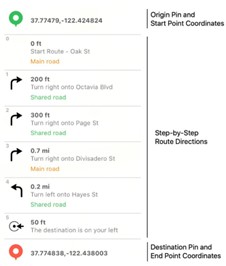1. Introduction
Cycling Routing provides users with step-by-step cycling routes between a user’s current location and their requested destination.
For each task, you will be provided with a single cycling route. You will research the route and record any Major Navigational Errors (MNEs) or Other Issues (non-MNEs).
These guidelines explain how to use the web-based Rating Tool and how to identify MNEs and other common cycling route issues. You will use a combination of provided map layers (with a focus on satellite views) and online resources to understand the actual, physical layout (or “ground truth”) of cycling routes to determine if the route you are reviewing contains errors.
1.1. Cycling Evaluation Notes
Cyclists should follow the same rules of the road as other drivers. If it is illegal for a car to perform a maneuver, it is illegal for a cyclist too. Review local laws whenever there is any doubt about the legality of a maneuver.
Some route segments may have access restrictions that apply only to cyclists. Similarly, some paths or lanes are restricted to be used only by cyclists and/or pedestrians. Be sure to review the correct access for each segment of the route.
Bike lanes, speed limits and other factors can affect the overall safety and quality of a cycling route and should be considered for every route segment.
1.2. The Rating Tool
The web-based Rating Tool for Cycling Routing is where you will find specific information about each route and where you will record each of your ratings. It is divided into six types of information: ETA, Elevation Profile, Step List, Map View, Route Information and Rating Questions.
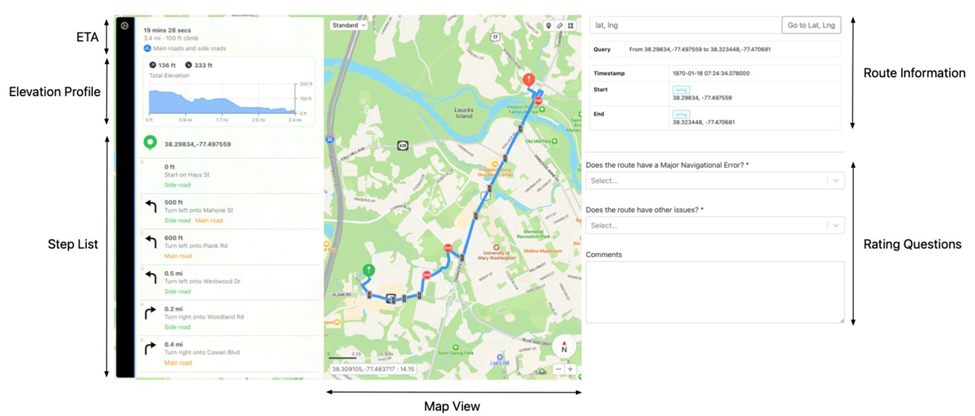
The following sections explain how to use each part of the Rating Tool and introduce you to the Rating Questions for Cycling Routing evaluation.
1.2.1. ETA
The ETA section summarizes the time and distance of the suggested route. Distances throughout are measured and displayed in either meters or kilometers:
- Time to Destination – Estimated time to reach the destination from the route origin point
- Distance to Destination – Route distance from origin to destination • Route Summary – This will be displayed as one of the following:
- Text Summary based on the overall elevation profile of the routes (e.g. ‘gentle hill’, ‘mostly flat’, etc.)
- Measure of the total cumulative climb
- Route Advisories – Advisories indicate any special considerations that apply to the route

1.2.2. Elevation Profile
The Elevation Profile summarizes:
↗ Elevation Gain – Sum of every increase in elevation along the cycling route. This measurement does not include any losses in elevation.
↘ Elevation Loss – Sum of every decrease in elevation along the cycling route. This measurement does not include any gains in elevation.
• Cross-Sectional Profile – Section view of the route landscape, showing all elevation changes along the route.

You can also interact with the profile. When you hover your cursor over the Elevation Profile, a pop-up text field will appear that displays the distance and elevation at that point on the route.

1.2.3. Step List
The Step List is located on the left side of the Rating Tool and includes:
- Coordinates for the route’s Origin and Destination Pins

- A Step-by-Step List of route directions
The Step List begins with a green Origin Pin, defined by
Start point coordinates, and concludes with a red Destination Pin, defined by End Point coordinates. The final step for each route will indicate the orientation of the destination to the End point (ahead, left, or right).
The Step List may include, but is not limited to, the following symbols:


Ech of the Step-by-Step Route Directions includes:
- Step ID – Each step is numbered, beginning with ‘0’. Step IDs are located in the upper left corner of each step.
- Maneuver Icon – Each step may include an arrow/icon, indicating guidance directions, such as turn directions.
- Distance to the Maneuver – This is the distance to the the start of the step maneuver.
For example, this number might be used in the sentence, “In 65 meters, turn left onto Polk Street” (as in the screenshot, above).
- Routing Guidance – Routing guidance is displayed as text instructions, and may include specific maneuver information, such as turn directions and street names.
- Road Descriptions – Types of roads/paths and the availability of bike lanes, etc. will be noted here. Road Descriptions are color-coded, based on their level of bike-friendliness (e.g. green = safe for bikes, such as a dedicated bike lane or path; orange = legal for bikes, but may be shared with others; red = bikes are restricted).
Notes on Step-by-Step Directions
While you will not need to evaluate the specific wording of the Routing Guidance, Road
Descriptions must accurately describe each route segment (See Sec. 2.2.5. Road Descriptions).
When leaving a comment on a route error, you must include the Step ID. You will also record the coordinates that indicate the location of the error in the appropriate lat/long fields.
Interacting with the Step List
In addition to outlining the route and individual route directions, the Step List can be used to control the appearance of the Map:
- Click on a single step in the Navigation Directions to highlight that route step in the Map View.
- Double click on a step in the Navigation Directions to zoom in on that step in the Map View.
- If the Step-by-Step list is longer than can be displayed on the screen, the Step List will become scrollable.
1.2.4. Map View
The Map View is located in the center of the Rating Tool. A blue Route Line indicates the cycling route between the Start and End points and should reflect all of the individual Route Directions from the Step List. The green Origin Pin indicates either the user’s location when the route was requested or the location that the user requested the route to begin at. The red Destination Pin indicates the location that the user wants to navigate to.
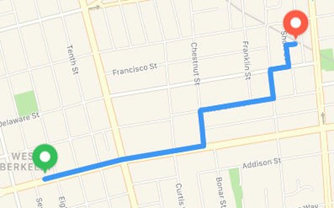
A Map Layer Selector, located at the top left corner of the Map View, allows you to switch between the following Map Layers.
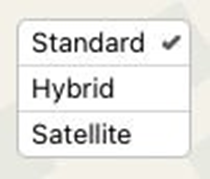
- Standard – The Standard Map depicts streets and highways, towns and cities, business names, green spaces, and bodies of water, etc.
- Hybrid – Elements from the Standard Map, including roads, street names and town/city names, are superimposed upon a Satellite View.
- Satellite – An unlabelled, photographic satellite view.
Always conduct research using available satellite and street imagery to evaluate cycling routes.
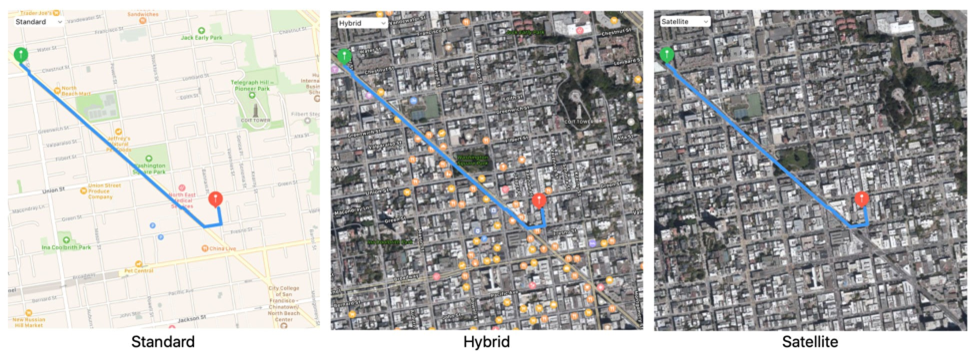
Map View Tools
| Tool Icon | Name and Description | |
 | Select the Pin Drop Tool andthen click on the map to drop a pin. Once the pin has been placed, a flag will open that lists the pin’s Address and Coordinates (latitude and longitude). Select ‘Delete Pin’ from the pin flag to toggle it off. | 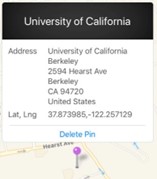 |
 | Select the Measure Tool andthen click on two points on the Map. Once two points have been selected, a dashed line will be drawn between those points and the measurement, determined in meters, will appear next to the Measure Tool icon. Select the Measure Tool again to toggle it off. | 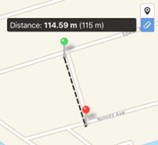 |
 | A Zoom Controller allows zooming in and out of the Map View. You can change the zoom level by clicking the + (zoom in) or – (zoom out) buttons. | |
| A Map Scale allows you to determine relative distances between points on the map. The scale will automatically adjust, based on the map zoom level. Lat/Long Coordinates allow you to determine and record precise locations. | ||
In addition to the Map Selector, the Map View has several more tools that will help you to find coordinates at a selected location on the map, measure the distance between two points, zoom in and out of the map, and measure the relative distances of elements on the Map.
1.2.4.1. The Cycling Route Line
The Cycling Route Line is a blue line that corresponds to the cycling route nd connects the route’s Start and End Points, which are fixed points at each end of the blue line. In this evaluation, you will identify the presence of any Major Navigational Errors (MNEs) or Other Issues by reviewing the safety and legality of each step that a cyclist will need to perform in order to follow the route indicated by the blue line.
The Route Line is usually drawn down the middle of each Step of a route. Though the blue line may appear to be in the center of roads and streets, we do not expect cyclists to ride down the middle of vehicular roads. Instead, the Route Line is provided as a visual reference that is associated with bike-friendly paths, roads, and crossings that make up the Cycling Route.
| Satellite View | Standard Map View |
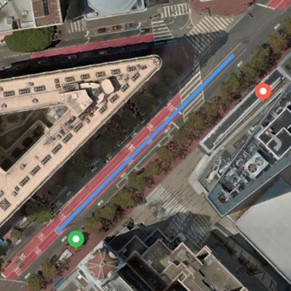 | 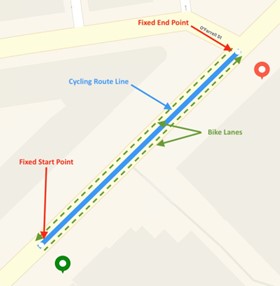 |
| The Standard Map View (above right) illustrates the relationship between the blue Cycling Route Line, its fixed Start and End Points, and its associated bike paths. The Cycling Route associated with this route runs adjacent to the Route Line but does not appear in the Satellite View (above left). Cycling routes are not always required to use existing Bike Lanes. They may use bikelegal roads, paths, trails, or bike lanes. Bike lanes, however, are not illustrated in the Rating Tool’s Map Views (Standard, Satellite, or Hybrid), so you will need to conduct research to understand the ground truth of Cycling Routes based on the path of the Route Line and specific Route Directions from the Step List. | |
Dismount Zones
A Dismount Zone is a route segment or location where a cyclist is required to get off of their bike and walk. A dismount zone will be indicated by a ‘no bikes’ icon on the blue cycling route line.
The dismount zone may span an entire step, or it may only be applied to a section of a route step. Dismount zones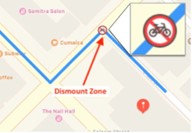
may occur t any point along a route and may appear in multiple locations.

Often the reason for the dismount zone will be explained by the road description for the corresponding route step. For example, the Road Description for this step indicates that the route ends on a Pedestrian-Only route step.
Cycling Route Icons
Cycling route icons may be displayed on the route line, usually marking the location of dismount zones. Cycling route icons may include, but are not limited to:
Pedestrians only – Bikes are not allowed to be ridden

Steep elevation gain
Origin and Destination Pins
Origin and Destination Pins will also appear with each route. Though the Route Line may appear to connect the Origin and Destination Pins, the Pins are not the subject of this evaluation. This is because we assume that the Origin and Destination Pins are always acceptable to the user. For this reason, your ratings should never be based on:
- the location of the green Origin or red Destination Pins
- the relationship between the Pins and the Cycling Route Line
| Satellite View | Standard Map View |
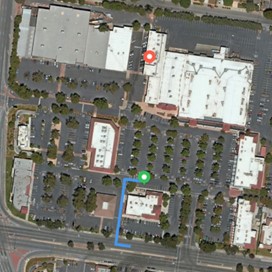 |  |
1.2.5. Route Information
Route Informtion is located in the upper right corner of the Rating Tool. Here you can confirm the current evaluation task type, the locale of the task, and other route-specific details:
- Go to Lat, Lng allows you to zoom to the location of specified latitude and longitude coordinates in decimal notation
- Query lists the Start and End coordinates for the cycling route.
- Timestamp represents the date and time that the user requested the route. The Timestamp (when available) can be used
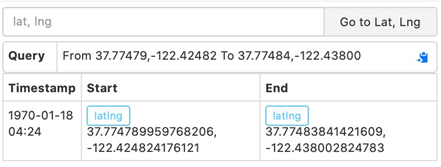
to help determine time-based access restrictions, such as bike paths that open and close at a specific time each day.
- Start Coordinates represent the user’s location at the time that they requested the route. Similarly, the End Coordinates represent the location that the user is traveling to. This information should match the corresponding coordinates listed in the Step List.
1.2.6. Rating Questions
Your ratings and comments will be collected in the Rating Questions section, found in the lower right corner of the Rating Tool. You will answer two result-level questions. You will also provide any necessary notes in the comments field.
- Does the route have a Major Navigational Error?
- Route has Other Issues?
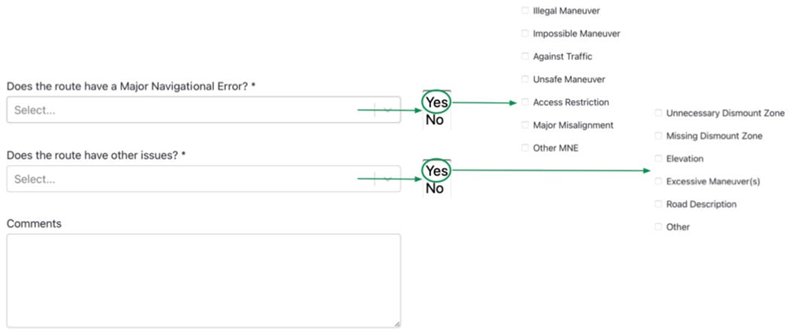
If you indicate that a route has one or more errors, by responding Yes to either of the first two questions, a checkbox list of error types will appear. Check all boxes that apply. In cases where multiple error types occur on the same route, check the box corresponding to each error.
Indicating that a route has one or more errors will also reveal a Latitude and Longitude text field. Enter the lat/ long coordinates for the location of the route error.

Do not enter comments in the lat/long texts fields.
1.2.7. Comments
Comments are mandtory anytime that you identify a MNE or Other routing issue. Use the comments field to explain any issues that influenced your ratings. Be sure to:
- Refer to the Guidelines – If the rating is due to rules stated in the guidelines, note the guideline/rule that guided your decision.
- Be concise – Don’t write elaborate comments. Be short and specific.
- Be Specific – include the Step ID and a description of each error. Distinguish between multiple errors by referring to each error type and lat/long location.
- Comment in English – Your comments will sometimes be reviewed or used by people who are not familiar with your test locale or language. Comments in English are understood by the widest possible audience.
2. Rating Questions
In this task, you are asked three primary questions:
- Does the route have a Major Navigational Error?
- Route has other issues?
In some cases, you will also be required to leave comments. The following sections define the error types and rules used to answer these questions.
2.1. Major Navigational Errors (MNEs)
The first question you will answer is “Does the route have a Major Navigational Error?”
Major Navigational Errors (MNEs) are illegal or impossible route maneuvers that cause a route to be unusable by cyclists. Errors in a route that would force the user to abandon the original route, or would cause a re-route, should be considered MNEs. If you notice any of the following Major Navigational Errors (MNEs) when reviewing the route, you should select Yes for the question, “Does the route have a Major Navigational Error?”
- Illegal Maneuver – The route navigates the user into an illegal maneuver (e.g. a restricted left, right, or u-turn).
- Impossible Maneuver – The route uses roads that do not exist in real life or maneuvers that are impossible to perform (e.g. maneuver ignores differences in overpasses/ underpasses, physical barriers between roads, etc.).
- Against Traffic – The route navigates the user against the legal direction of traffic flow. Against Traffic is primarily used when we have evidence that the user will believe that they are being routed the wrong way down a dual-carriageway or one-way road.
- Unsafe Maneuver – The route navigates a user to make a maneuver that would not be safe to perform. .
- Access Restriction – The route navigates through an area that limits road usage to only those with special access (private roads, parking lots, gated communities, military bases, etc.). Access Restriction is also applied for time-based restrictions. These are based on the time that a user would be expected to arrive at that step in the route, if a route timestamp is provided.
- Major Misalignment – A misalignment is any section of the Route Line that does not match the ground-truth shape and position of the cycling segments included on the route. Any route that is more than 50 meters from the intended walkway location should be considered a Major Road Misalignment.
- Other MNE – When the route includes a maneuver that is illegal, but does not fit into the other MNE categories, you should apply a rating of Other MNE. When rating Other, make sure that you provide a detailed comment that thoroughly explains the issue and how it violates the law.
Some routes may have multiple Major Navigational Errors. Use the provided checkboxes to indicate each instance of a MNE that occurs along the route. Enter the lat/long coordinates for the location of the MNE in the MNE lat/long text field. Do not enter anything other than the copied latitude and longitude into this field. Explanatory text should go into the Comments text box.
Once you have fully reviewed the route, you will begin by assigning one of the following rating options:
| Rating Option | Explanation |
| Yes | There is a Major Navigational Error on the Cycling Route. |
| No | There are no Major Navigational Errors on the Cycling Route. |
If you respond, Yes, because there is a MNE on the cycling route, a checkbox list of MNE types will be displayed. You will need to select each MNE that applies from the checkbox list.
2.1.1. Illegal Maneuver
An Illegal Maneuver occurs when any maneuver would be considered illegal in the locale where the route is located. Examine signage and road markings along the route to identify potential illegal maneuvers. Keep in mind that cyclists must obey the same restrictions as automobiles, in addition to any other restrictions placed on cyclists. If there is any doubt about the legality of a maneuver, review local cycling and traffic laws.
| Satellite View | Standard Map View |
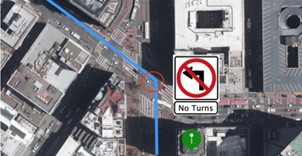 | 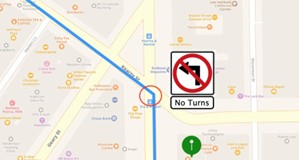 |
| In this route, the cyclist is instructed to begin on Market Street and to turn left onto Kearny Street. However, at this intersection, there are several traffic signs which restrict all turns at this intersection, with the exception of taxis and public street cars. Since cyclists are restricted by the same laws as car drivers, this should be considered an Illegal Maneuver. | |
Any cycling route that violates a posted turn restriction, including u-turns, should be rated an Illegal Maneuver.
2.1.2. Impossible Maneuver
An Impossible Maneuver occurs when the route suggests that the user perform a maneuver that the average cyclist couldn’t perform.
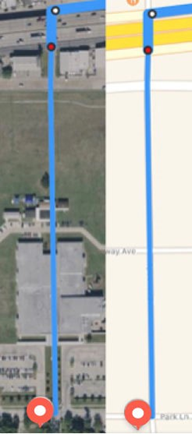
The route uses paths that do not exist in real life or provides maneuvers that are impossible to perform. For example, the route may ignore differences in road heights, ask the user to cross a physical barrier, or other similar impossible-to-perform actions.
In the route shown on the right, the route makes a left turn to proceed south. The Satellite View makes this case appear as if the route is navigating along a road that does not exist and then directly through multiple school buildings.
When we see a case like this we should review it in multiple providers and review any available street imagery. If we are unable to determine that a new road has been constructed, the route should receive a rating of Physically Impossible for using cycling paths that do not exist and indicating we should ride through a building that is not accessible to the public.
| Satellite View | Standard Map View |
 | 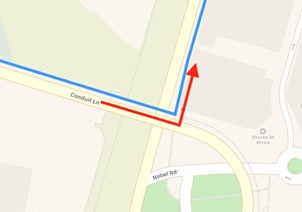 |
| This route travels across an overpass on Conduit Lane. However, the route makes a sudden left from the upper level of the overpass down to the lower road. There is no access by stairs at this point from Conduit Lane to the lower road, so this route should be rated as having an Impossible Maneuver MNE. | |
| Satellite View | Standard Map View |
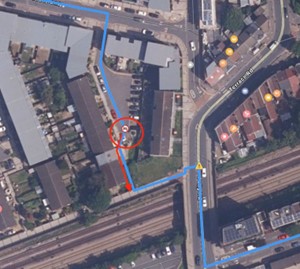 | 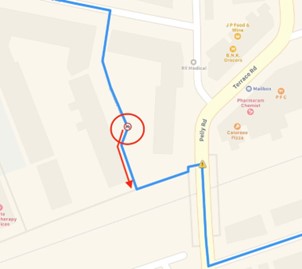 |
| This route instructs the user to travel into a cul | |
| the red circle) and proceed on foot though the | block (red arrows) to a walking path. Satellite |
| and street imagery show that there is a fence a | nd private yard at the end of the cul-de-sac, |
| preventing all public traffic from traveling alon | g the indicated segments. Since the route leads |
| the cyclist along a segment that does not exist Maneuver MNE. | , this should be rated as an Impossible |
 | 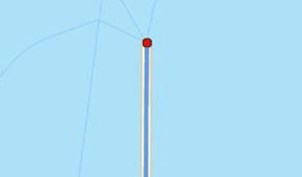 |
| This route indicates that a road exists in the middle of what is clearly the ocean. After investigating the route and becoming certain that the road indicated is not actually an underwater tunnel or ferry, we can rate this as an Impossible Maneuver MNE for ending on a non-existing road. | |
2.1.3. Against Traffic
An Against Traffic MNE occurs whenever a user is instructed to travel on a road or path against the legal direction of traffic. When reviewing the route, check any signs and road markings related to traffic directionality to ensure that each segment of the route safely travels in the correct direction.
Dismount Zones
If a route instructs the cyclist to dismount prior to following a segment that goes against traffic, this should not be considered an Against Traffic MNE. For example, if a rider is instructed to dismount their bike before traveling in the wrong direction on a one-way street to their destination or the next route step, this is not a MNE, as long as it is legal and safe to walk the bike on the sidewalk.
One-Way Streets
Pay close attention to one-way streets. If the route contains any one-way roads or paths, you should verify that the cycling route is obeying the legal direction of traffic on those roads.
| Step List | Standard Map View |
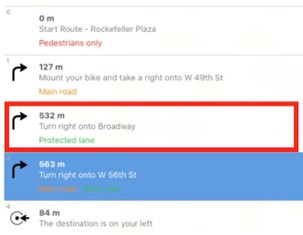 |  |
| This route turns right onto Broadway (red arrow). However, online street imagery reveals that Broadway is a one-way street at this intersection (moving in the direction indicated by the one-way sign). Since the route turns onto a one-way road, traveling in the wrong direction, and the user is not instructed to dismount at this intersection, this should be rated as having an Against Traffic MNE. | |
| Satellite View | Standard Map View |
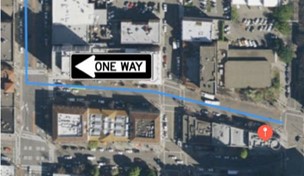 | 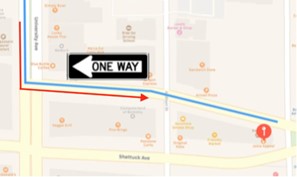 |
| This route travels South on University Avenue before turning left onto Shattuck Avenue. The user is not instructed to dismount at this intersection. Available online street imagery shows that the segment of Shattuck Avenue, between University Avenue and the route destination is a one-way road (moving in the direction of the red arrow). Since the route turns onto a oneway road, traveling in the wrong direction and the user is not instructed to dismount their bike, this should be rated as having an Against Traffic MNE. | |
Divided Roads
Routes along Divided Roads, where the directions of traffic are divided by a median, may indicate, or limit, which side of the road a cyclist may legally use. If a route travels along a divided road, ensure that the cyclist is not directed to use the wrong side of the divided road, which would cause them to travel against the direction of legal traffic.
| Satellite View | Standard Map View |
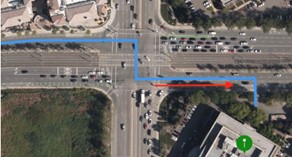 | 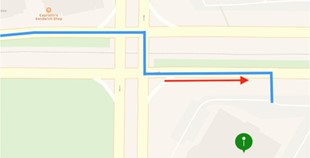 |
| Tasmin Drive is a divided road with traffic moving in opposite directions on either side of a series of rail tracks. This route begins by turning left onto the South side of Tasmin Drive, against the direction of traffic, where the legal direction of traffic is indicated by the red arrow. Although the route changes sides to the North side of Tasmin Drive at the following intersection, this route segment on the South side of Tasmin Drive is an Against Traffic MNE. | |
Rounabouts
A cyclist must ride in the same legal direction of traffic as automobiles, including through traffic circles.
| Satellite View | Standard Map View |
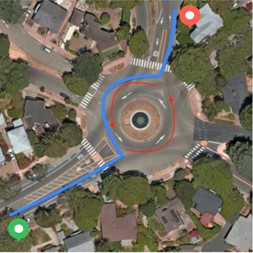 | 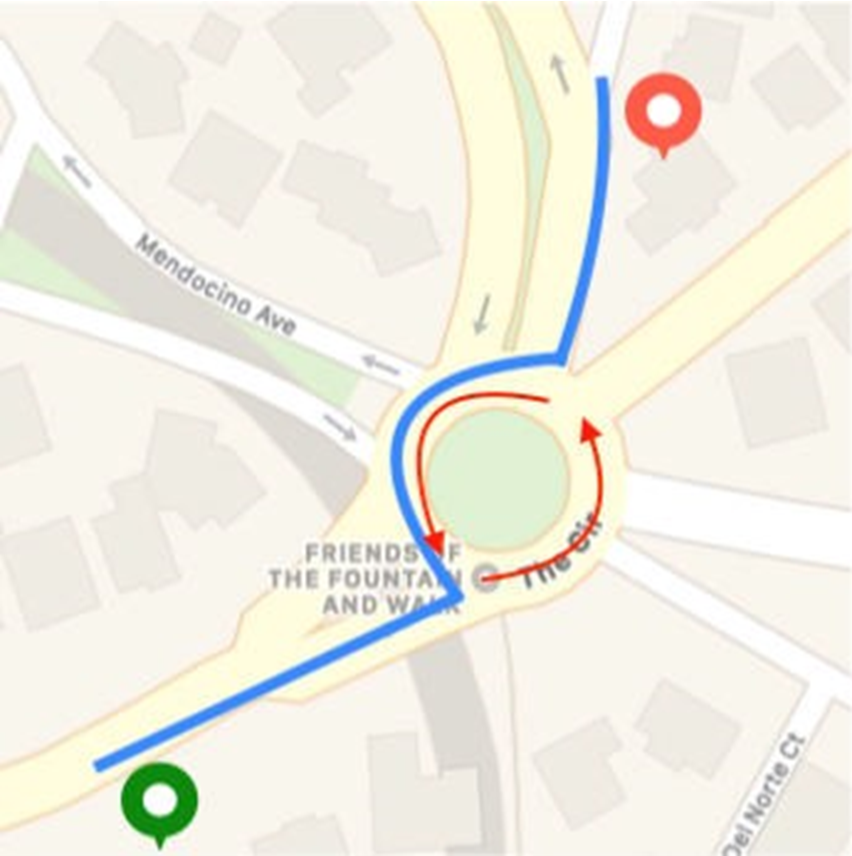 |
| In the example above, a cycling route directs the user to enter a roundabout and travel counterclockwise, against the flow of legal vehicular traffic (red arrows). This route should be rated as having an Against Traffic MNE. | |
2.1.4. Unsafe Maneuver
A cycling route should be rated as having an Unsafe Maneuver if it requires a user to perform any maneuver that would be potentially dangerous. For example, sharp turns in heavy traffic areas, unnecessary use of a busy intersection with rail crossing, or road segments should be rated as Unsafe Maneuvers.
Maneuvers
As you examine the route, look for sharp turns or maneuvers that seem unnecessary. If a route includes a maneuver that appears to be severe or unnecessary, this may be an indication of an error in the route. Look closer, using available map layers and online imagery to understand the maneuver’s ground truth. Some possible signs of an unsafe maneuver may include, but are not limited to:
- Unnecessarily sharp turns across traffic
- Unnecessary turns across multiple lanes of traffic at an intersection that is not controlled by a stop sign or stop light • Unnecessary u-turns on a busy road
- Confusing maneuvers that would cause a cyclist to perform a potentially dangerous maneuver
- Short route segments that would require a cyclist to cross multiple lanes of traffic on a busy street
| Satellite View | Standard Map View |
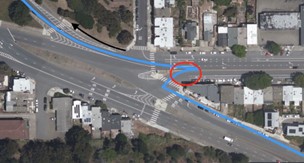 |  |
| In this case, the user is instructed to “Take a sharp left turn onto Sagamore St”, but this requires the cyclist to cross a yellow line and make a fast sharp turn into traffic, while crossing multiple lanes of traffic. This should be rated as an Unsafe Maneuver. | |
| Satellite View | Standard Map View |
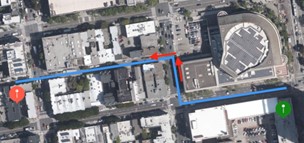 |  |
| This route turns right onto Franklin Avenue, a busy one-way street with three lanes of traffic in downtown San Francisco. The route quickly turns left onto Ivy Street (red arrows). Though bike traffic is legal on both Franklin Avenue and Ivy Street, the left turn maneuver onto Ivy Street would require a cyclist to cross three lanes of traffic within a short distance. This would be an unnecessarily difficult and potentially dangerous maneuver. This should be rated as an Unsafe Maneuver. | |
Roadways
For each route segment, also review the speed limit, width of street, and number of lanes to determine if a maneuver or street presents a potential danger to a cyclist.
Unsafe roads may include, but are not limited to:
- Limited access highways
- Roads with speed limit of 50mph or more
- Roads with more than 5 lanes of traffic
| Satellite View | Standard Map View |
 | 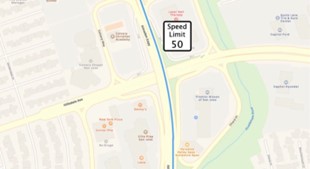 |
| This route directs the user to travel along Almaden Expressway, a busy urban expressway with fast moving traffic. Research, using street imagery, reveals that this road has 6 lanes of traffic and has a speed limit of 50 mph, but does not have a dedicated bike lane. Research also reveals that there are other, safer roads available that the cyclist could have been routed onto. Directing a cyclist to unnecessarily take a potentially dangerous route should be considered an Unsafe Maneuver. | |
| Satellite View | Standard Map View |
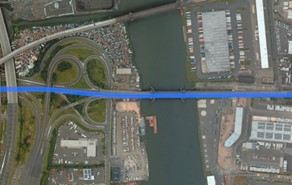 |  |
| This route directs the user to travel along a br | idge on the Lincoln Highway in New Jersey that |
| crosses the Passaic River. Online street imager | y reveals that this is a busy bridge with 6 lanes |
| of traffic. While there is a pedestrian walkway, | you should not assume that the cyclist is |
| intended to move onto the sidewalk unless t | he route step specifies that the user dismount |
| and take the pavement walkway. Traveling on | the roadbed of this bridge would be potentially |
| dangerous and should be considered an Uns | afe Maneuver. |
 |  |
| This route directs the user to cross Central Park in New York City by using the 97th Street Traverse. Online street-level imagery reveals that this is a two-lane road with no sidewalk on the right side of the road in the direction that the route is traveling. There are also two short tunnels (indicated by red circles) that do not allow ample space for traffic to pass slower moving cyclists. Though this segment of the route would be legal for bike traffic, the narrow lanes, traffic, and lack of a sidewalk or shoulder along segments of the 97th Street Traverse, make this an unsafe roadway, so this should be rated Unsafe Maneuver. | |
2.1.5. Access Restriction
A cycling route should be rated as having an Access Restriction if it passes through any area, where road signs and painted marking on roads indicate that bikes are not allowed to travel along any segment of a route. When reviewing the route, check any signs and road markings related to bike access to ensure that there are no restrictions.
A route should also be rated as having an Access Restriction if it passes through an area, including private property, that would typically be safe and legal for a cyclist to use, but signage or time-of-day laws prevent bike usage. An Access Restriction occurs whenever a route navigates through a private road or property that are not associated with the Start or End Points on the Cycling Route Line.
Private Property and Gated Communities – If the route begins or ends in a private access area, it should be assumed that the user has access to that area. For example, there are many private and gated communities that only allow access to those who live within the gated community and invited guests. A route that navigates through, but does not begin or end in, a gated community is considered to have an access restriction as we cannot assume an average user would be allowed access to ride their bike through the gated community. However, if the route begins or ends in the gated community, the assumption is that they are a resident or invited guest and that they are intentionally trying to navigate inside of the private, gated community.
Time Restrictions – Time Restrictions may occur on any step along a route, including bike trails, parking lots, and public parks. For example, in some locales, it may not be legal to route through a park at night. For time of day laws, evaluate any step that has a time restriction by referencing the time that the user would arrive at that step. Time can be determined by using the route’s Timestamp and adding all previous step durations. The initial Timestamp for each route is noted in the Route Information table in the Rating Tool.
Parking Lots – Cycling Routes may begin, end, or travel through publicly accessible parking lots. If a Cycling Route travels through a parking lot, that parking lot must be safe and legal to bike through, and must not have a Time Restriction that coincides with the route’s Timestamp. However, if a route travels through a parking lot that is located on private property and is not meant for public use, or is otherwise not publicly accessible, Access Restriction should be selected. Non-publicly accessible parking lots include any lot that has signage, gates, or security that restrict public access, as well as paid parking garages/lots that are only intended for persons who have paid to park on the premises.
| Satellite View | Standard Map View |
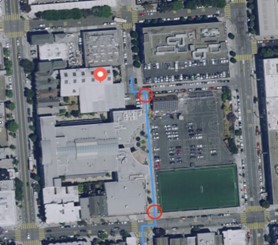 |  |
| In the example above, the route appears to tra | vel along a street through a city block. |
| However, research reveals that this route bise | cts a high school property and street imagery |
| further reveals that access to this route is rest | ricted by locked gates (located at each of the |
| red circles above). Since public access to this | step of the route is explicitly restricted, this |
| route should be rated as having an Access R | estriction. |
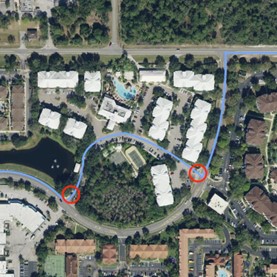 |  |
| Here the route directs the user to ride through a parking lot and property for a hotel. Research reveals, however, that access to the hotel is restricted to hotel employees and guests. Access is enforced by the presence of security gates (located at each of the red circles above). The route does not begin or end at this property and we cannot assume that the user has access to this area, so the route should be flagged as having an Access Restriction. | |
| Satellite View | Standard Map View |
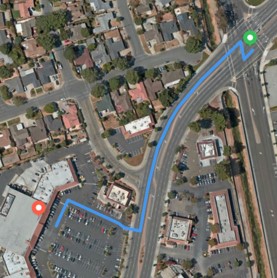 |  |
| This route ends on the tarmac of an airport. The blue route line is following a road that outlines the airport. A security checkpoint at 19.100802,72.877051 would prevent most users from cycling along this route. However, because the blue route line ends within a restricted access area, we assume that the pedestrian requesting the route has access to this area, so we would not consider this a MNE. | |
2.1.6. Major Misalignment
A misalignment is any section of the Route Line that does not match the ground-truth shape and position of the cycling route segments included on the route. Misalignments occur when routes have significant errors in how they are mapped or the blue Route Line is incorrectly drawn. Misalignments can range in severity; most cases are minor and unlikely to be noticed by a user. Only Major Misalignments that are likely to confuse a user and cause a navigational error should be rated as a Major Navigational Error.
- A major misalignment is more than 50 meters from the blue route line to the present day ground truth of the cycling path or road.
- A missing or non-existent roundabout/traffic circle that measures 50 meters or more in diameter from the edge of outer lane at the widest point
| Satellite View | Standard Map View |
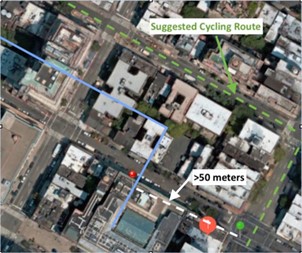 |  |
| This route line is not aligned with the Satellite or Standard Map Views. The last step on the route is more than 50 meters from the correct cycling route. The route could be confusing to a user, who would not know wether to turn south on 3rd Avenue or Broadway Alley, and turning south on Broadway Alley would require that the user bike more than 50 meters to the correct destination. Since the misalignment is more than 50 meters from the ground-truth shape and position of the route and may confuse the user, this should be considered a Major Misalignment. | |
Roundabouts
Roundabouts and traffic circles are circular intersections where traffic flows in a single, circular direction around a center point. Drivers entering the traffic circle yield to traffic already in the roundabout. After entering the roundabout, they drive around the center point until they reach an exit point to the road they wish to travel on.
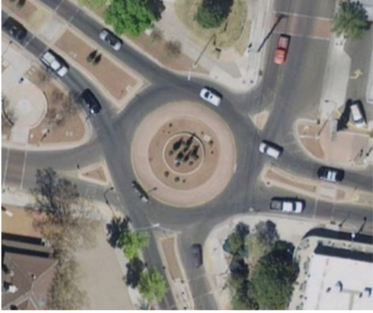
To qualify s a Major Misalignment, a missing or non-existent roundabout must be 50 or more meters wide at the edge of the outer lane at the widest point of the roundabout. If the widest point of the roundabout is under 50 meters, rate it as a Non-MNE Other Issue (see 2.2.6.2. Minor Route Misalignments).
If the roundabout exists only on the blue line, you should measure from the widest point on the blue line to the implied center-point of the roundabout and double that width. If the doubled width is greater than 50 meters, it should be considered a Major Misalignment MNE.
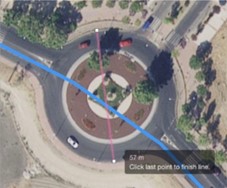 | A 57 meter wide space exists from edge-to-edge on this roundabout. A missed roundabout like this should be rated as having a Major Misalignment MNE. |
2.1.7. Other MNE
When you notice the route performing a maneuver that is illegal or unsafe but does not fit into any of the MNE categories, you should apply a rating of Other MNE.
When rating Other MNE, make sure that you provide a detailed comment, thoroughly explaining the issue and how it violates the law or creates an unsafe situation for the cyclist.
2.1.8. MNE Lat/Long Coordinates
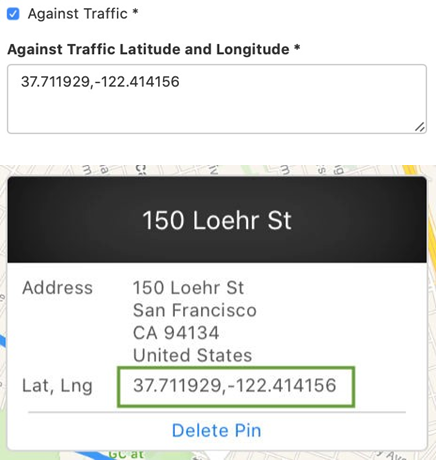
Indicating that a route has one or more errors will also reveal a Latitude and Longitude text field. Enter the lat/ long coordinates for the location of the route error that you identified in this field.
Enter only the numerical latitude and longitude coordinates in these text fields.
Do not add additional comments, explanations, formatting, punctuation, etc.
To prevent errors in transcribing lat/long coordinates, use the pin drop tool to obtain the coordinates, then copy them directly into the text field.
If more than one instance of the same MNE or Other Issue type occurs on the same route, enter lat/long coordinates for each instance.
Place each lat/long pair on separate lines, with no additional formatting.
For Major Misalignment MNEs, enter the lat/long coordinates of the point at which the misalignments begins. If the entire route is misaligned, enter the route’s Start Point Coordinates.
2.1.9. Multiple MNE Options
You may select more than one MNE option. Once you have reviewed the cycling route, check the boxes for each MNE type that appears on the route.
If more than one MNE occurs at the same location (i.e. identical lat/long coordinates), choose the MNE that would have the most severe impact on the cyclist.
2.2. Other Issues (non-MNEs)
Next, you will indicate if there are any Other Issues on the route.
Other Issues (non-MNEs) may refer to cycling route quality issues or inaccurate route information. If you notice any of the following non-MNE issues when reviewing the route, you should select Yes for the question, “Route has Other Issues?”
- Unnecessary Dismount Zone – The route incorrectly instructs the cyclist to dismount their bike on a route segment where it is safe and legal for cyclists to ride.
- Missing Dismount Zone – A step on the route fails to indicate that the segment requires the cyclist to dismount from their bike to complete the step.
- Elevation – The route includes unnecessarily steep roads or paths.
- Excessive Maneuver(s) – The route makes frequent and/or unnecessary maneuvers.
- Road Description – The road descriptions in the Step List are missing or do not accurately represent the route segment.
- Other (non-MNE) – When the route includes a non-MNE issue that does not fit into the other non-MNE categories, you should apply a rating of Other. When rating Other, make sure that you provide a detailed comment that thoroughly explains the issue.
Some routes may have multiple non-MNE issues. Use the provided checkboxes to indicate each instance of a non-MNE that occurs along the route. Enter the lat/long coordinates for the location of each non-MNE in the corresponding lat/long text fields. Do not enter anything other than the copied latitude and longitude into this field. Explanatory text should only go into the Comments text box.
Once you have fully reviewed the route, you will begin by assigning one of the following rating options:
| Rating Option | Explanation |
| Yes | There is an Other Issue (non-MNE) on the Cycling Route. |
| No | There are no Other Issues (non-MNEs) on the Cycling Route. |
If you respond, Yes, because there is an Other Issue (non-MNE) on the cycling route, a checkbox list of Other Issue types will be displayed. You will need to select each non-MNE that occurs on the route from the checkbox list.
2.2.1. Unnecessary Dismount Zone
In this screenshot, a dismount zone is indicated by the ‘nobikes’ icon. Dismount Zones, like this one, indicate where a cyclist will need to get off of their bike and walk.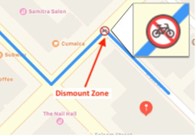
Always conduct research to verify that any dismount zone is accurate and necessary. If a dismount zone does not represent a real world cycling restriction, or is otherwise not needed, then it is as an Unnecessary Dismount Zone.
Researching Dismount Zones
Whenever you see a dismount zone, begin your research by looking at the Step List to see if a cause is indicated in either the Routing Guidance or Road Description. In this example, the routing guidance explicitly instructs the cyclist to dismount and the road description alerts the cyclist that this is a pedestrian-only segment.
The Road Description explains the reason that the dismount zone appears on the route. However, you still need to verify this against ground truth. Use available map layers and recent online street imagery to determine if this is a true dismount zone in the real world.
In this case, the cyclist must travel against traffic on a oneway street in order to reach their destination. The route correctly indicates that the cyclist must dismount their bike in order to safely and legally complete the route, so this should not be considered a route error.
| Satellite View | Standard Map View |
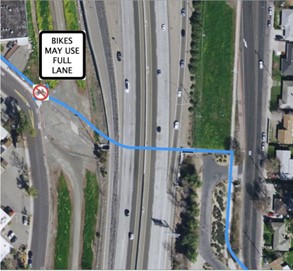 | 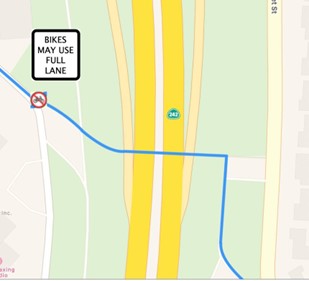 |
The following are examples of dismount zones and how to rate them.
| Satellite View | Standard Map View |
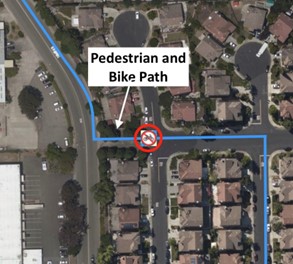 |  |
| A dismount zone is displayed at the point where a road beces a pedestrian and bike-only path. This small section of path connects two streets, but cars are prohibited. Bike and pedestrians, however, are not, so this is an Unnecessary Dismount Zone. | |
 |  |
| The last step of this route has a dismount zone (in red). Research reveals that the route ends by turning left onto a pedestrian sidewalk. The cyclist is instructed to continue the route, but to dismount at the point that they will begin to travel along the pedestrian sidewalk. This is an accurate and necessary dismount zone and should not be considered a non-MNE. | |
2.2.2. Missing Dismount Zone
As you conduct research along the cycling route, you should also look for any instance where the cyclist should be required to dismount and walk their bike, but a dismount zone is not displayed.
Dismount Zones are expected and should be displayed whenever a restricted route segment is necessary to complete the route. Examples of expected dismount zones include, but are not limited to:
- Route begins or ends by traveling against traffic on a one-way street • Stairs
- Route uses pedestrian-only paths, bridges, or other infrastructure and there are no better bikefriendly alternatives
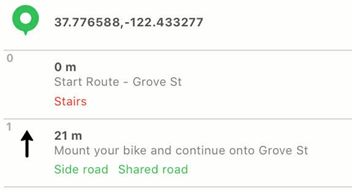
When a route begins with a dismount zone, the route
guidance may instruct the cyclist to mount their bike at the beginning of the subsequent maneuver.
Missing dismount zones require you to carefully examine the entire cycling route, being sure that there are no segments of the route that require a cyclist to walk their bike. When looking for missing dismount zones, it is a good idea to review every intersection and step transition, to ensure that there are no painted road markings or posted cycling restrictions that are not reflected in the cycling route.
| Satellite View | Standard Map View |
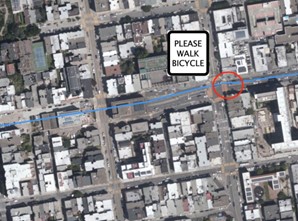 |  |
2.2.3. Elevtion
Review each route’s Elevation Profile to identify any errors in the cross-sectional elevation profile or the calculated elevation gains and losses. Differences between ground truth and the route data should be rated as Elevation errors.
Use the map layers, as well as satellite and street-level imagery, to help you to understand the ground truth geography of the route. Begin by reviewing the elevation profile carefully to identify any anomalies.
For example, this elevation profile reaches a maximum elevation of 1600ft, but the listed elevation gains/losses exceed 6600ft. This should not be possible and may indicate an issue with the elevation data.

Research reveals that the elevation data in this profile drops out at several points (indicated by the red arrows). Available online sources also indicate that these gaps do not represent ground truth changes in elevation, so this route should be rated as having Elevation issues.
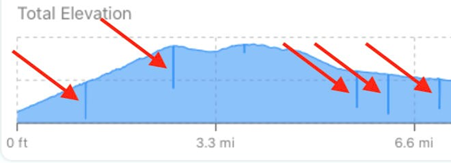
Elevation errors may occur at any point along a route. In addition to the anomalies described above, elevation errors may also occur when the elevation profile snaps to the wrong water, ground or roadbed level. For this reason, you should be particularly careful to review the locations of any of the following along the route:
- Tunnels
- If the bike route travels through or over a tunnel, the elevation for the correct roadbed level should be displayed in the elevation profile
- Bridges
- If the bike route travels across a bridge, the elevation for the bridge should be displayed in the elevation profile
- Overpasses/Underpasses
- If the bike route uses an over- or under-pass, the elevation for the correct level should be displayed in the elevation profile
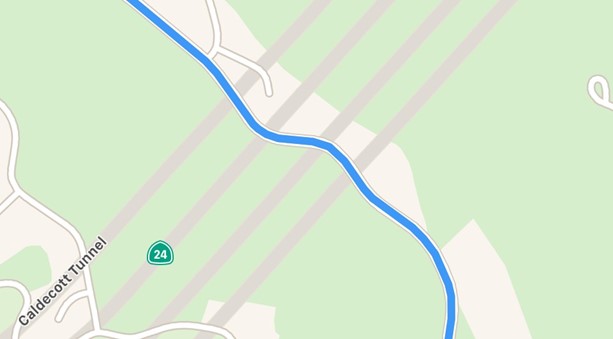 | |
 | This route travels along a road in the hills over the Caldecott Tunnel, a system of four traffic tunnels (red dashed lines). Although the bike path does not intersect with the tunnel, the elevation profile indicates sharp drops at the location of each tunnel. In addition, the listed elevation gain and loss display significant elevation changes, even though this entire route is roughly flat. This is a data inaccuracy and should be rated as a nonMNE Elevation issue. |
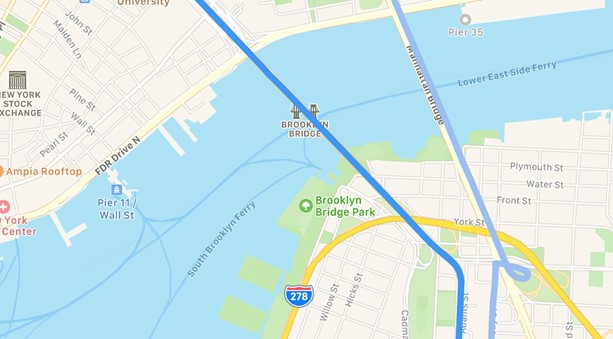 | |
 | This route travels across the Brooklyn Bridge, but the elevation profile displays a sudden drop at this location on the route and lists the elevation as 3 ft. Online resources verify that the bridge’s roadbed travels over the water at approximately 130 feet, so it is likely that the elevation data incorrectly reflects the water/ground level. This does not accurately represent ground truth, so it should be rated as a non-MNE Elevation issue. |
2.2.4. Excessive Maneuver(s)
Cycling routes should be direct, whenever traffic conditions, road patterns, and geographic features allow. An Excessive Maneuver(s) MNE occurs when one or more maneuvers create an inefficient route that ignores more direct, and equally safe and legal, route segments.
If a route appears to have more maneuvers than are necessary to reach a destination (e.g. a zigzag pattern, circular route, back tracking, etc.), you should conduct research to determine if the maneuvers are actually necessary.
As you conduct your research, keep in mind that some routes may utilize additional sets in order to navigate around steep elevations, high traffic areas, or dangerous roads. In other words, cycling routes may use more steps in order to stay on roads with less traffic and more bike lanes. If a route takes a safer route for cyclists, even if it may not appear to be the most efficient, this should not be considered an Excessive Maneuver(s) MNE.
Whenever possible, use local and cycling knowledge to determine which routes and route segments are required or not.
| Route 1 | Route 2 |

Both of the routes above have the same origin and destination points. The first route favors local side streets to safely and legally route to the destination. The second route, however, takes an unnecessarily long route to reach the destination, with more turns and a much longer time to destination. This is an extreme example of a route with Excessive Maneuver(s). Shorter routes, however, may also have excessive maneuvers, especially if an optimal bike route is overlooked.
| Route 1 | Route 2 |
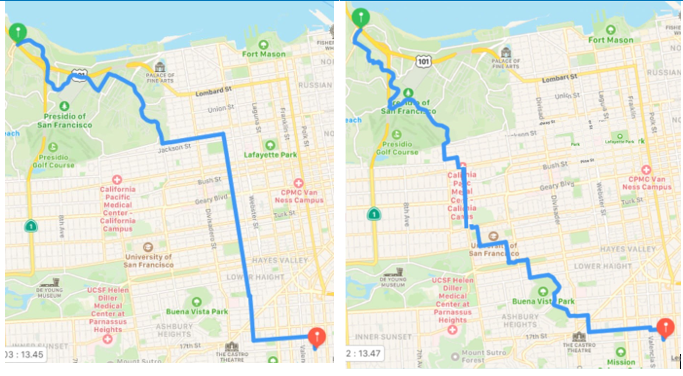
Both of the routes above hve the same origin and destination points. Route 1 favors a more direct route with fewer maneuvers and uses roads with bike lanes. Route 2, however, includes far more maneuvers. Reviewing the elevation profiles for each also reveals that Route 2 includes several segments with steep climbs. Since Route 2 unnecessarily follows a path with frequent maneuvers and steep climbs, it should be considered to have Excessive Maneuver(s).
2.2.5. Road Description
Road Descriptions are located in the Step List and describe the type of road that a route step uses, as well as any restrictions imposed on that step. If a road description is inaccurate or misleading, it should be recorded as a Road Description error.
Road descriptions will be listed for most steps in a route, but may not be listed for all steps. Each road description is also color-coded in the Step List, based on their level of bikefriendliness:
- Green – Safe for bikes, such as a dedicated and/or protected bike lane
- Orange – Legal for bikes, but may be shared with others, or have larger traffic volume
- Red – Bikes are restricted and/or a dismount zone is present
Road descriptions may include, but are not limited to:
- Main Road – A primary artery for through traffic. Main roads will usually connect larger neighborhoods and/or cities.
- Side Road – A minor or secondary road. Side roads usually connect neighborhoods to main roads or other road networks but are not generally used for through traffic.
- Shared Road – The road is shared between bikes and automobiles (and sometimes pedestrians), often with little or no distinction between lanes.
- Bike Lane – A lane on a roadbed that is dedicated to bike travel.
- Bike Path – A bike-dedicated path that is separated from automobile traffic.
- Protected Lane – Physical boundaries protect the bike lane from other modes of travel.
This may include curbing, medians, planters, posts, etc.
- Pedestrians Only (dismount zone) – Bikes are not allowed to be ridden.
- Stairs (dismount zone) – Stairs are located on the route step.
| Satellite View | Standard Map View |
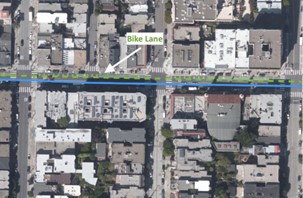 |  |
| The road description for this step accurately describes Polk Street as a Main Road; however, satellite and street-level imagery reveal that there is also a dedicated Bike Lane on this step. Since the bike lane is missing from the road description, you should rate this as having a Road Description error and provide comments to explain the issue. |  |
| Step List | Standard Map View |
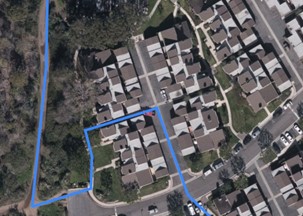 | 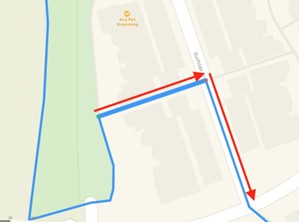 |
| The road description for this step incorrectly describes two route segments as having bike lanes (red arrows); however, satellite and street-level imagery reveal that there are no Bike Lane on these steps. Instead, cyclists will be required to share lanes with automobiles. Since the road description is inaccurate, you should rate both steps as having a Road Description error and provide comments to explain the issue. |  |
2.2.6. Other
While reviewing routes, you might notice that things look strange but do not meet any of the criteria for Major Navigational Errors or Non-MNEs, as they are defined above. Routes with minor quality or data issues should be classified as Non-MNE – Other, if you think the route has an issue that would create poor or mildly confusing user experience. When rating Non-MNE – Other, make sure that you provide a detailed comment to thoroughly explain the issue and how it would create a poor or confusing experience for a cyclist.
Some common examples of issues that can be considered Non-MNE – Other include, but are not limited to:
- A route that has a significant elevation climb, that might be difficult for a novice cyclist or would generally be avoided by local cyclists
- A route that navigates through or ends in small alleyways when locals would typically avoid them
- A route with minor misalignments between the blue line and road that do not merit a rating of Major Navigational Error
- A route whose blue line starts or ends in a clearly strange location given the origin or destination pins
The following sections include specific examples of some Non-MNE – Other issues.
2.2.6.1. Route Quality Issues Due to Elevation
Routes should avoid using very steep roads and paths, unless there is no other reasonable alternative route. If a route unnecessarily includes a very steep incline, the route should be rating as having a Non-MNE – Other issue.

Review the Elevation Profile on every route to identify any steep climbs. The elevation profile can be used to calculate the total elevation climb for a maneuver by recording the elevations at the beginning and end of a climb and then calculating the difference.
| Standard Map View with Elevation Profile and Explanation | |
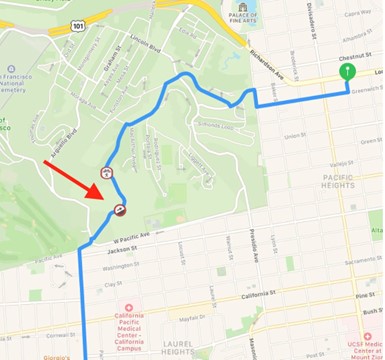 | |
 | This route has a steep 600ft climb which would be difficult for a novice rider. However, since there are other route options that could avoid the large climb and save some time, this route should be rated Non-MNE – Other. |
2.2.6.2. Minor Route Misalignments
A route with minor misalignments between the blue line and road that do not merit a rating of Major Navigational Error, should be rated Non-MNE – Other and a comment explaining the misalignment. Generally, minor misalignments occur when:
- The misalignment is less than 50 meters from the blue route line to the present day ground truth of the road
- A missing or non-existent roundabout/traffic circle that measures less than 50 meters or more in diameter
Most routes will have some level of misalignments occurring throughout the route. Minor misalignments are often caused by small errors in road shape data and the stylistic decisions made to visualize roads on a map.
| Standard Map and/or Satellite Views | Explanations |
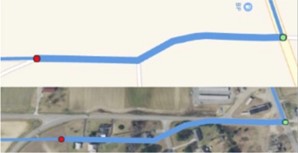 | The displayed route has a mismatch with the road’s true shape – the blue route line curves at a location where the road does not. The road is not misaligned over 50 meters, so this does not meet the criteria for a Major Road Misalignment. For a minor misalignment like this, you should select the Non-MNE – Other rating and explain the error in your comments. |
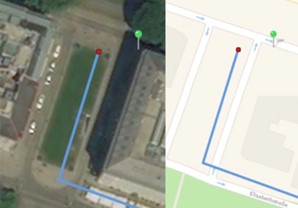 | In this route, the blue route line is not aligned with the road. This is an obvious misalignment as result of different road data being used to generate the blue route line and Standard Map Layer. Do not rate based on the Standard Layer. You should assume the Standard Layer a driver sees will match the blue route line. It’s likely a user here would not be confused by the road indicated. The map they are shown would have the blue line align with the underlying road that is capable of traveling south. The geometry is largely the same as reality, just poorly aligned. As it is under 50 meters off and not expected to be confusing, we would consider this a Non-MNE – Other issue. |
 | In this route, the user is instructed to make a sharp right turn. Because the center of the correct lane is never more than 50 meters off from the blue line, this should be rated as having a Non-MNE – Other issue. |
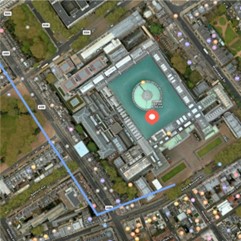 | In this route, the route line is clearly not aligned well with either road in the Satellite View. However, it’s likely that a user would not be confused. The geometry is largely the same as reality, just poorly aligned. As it is under 50 meters off and not expected to be confusing, this should be rated as a Non-MNE – Other issue. |
Roundabouts/Traffic Circles
If a roundabout exists only on the blue line, you should measure from the widest point on the blue line to the implied center-point of the roundabout and double that width. If the doubled width is less than 50 meters, it should be considered a Non-MNE – Other issue.
| Standard Map and/or Satellite Views | Explanations |
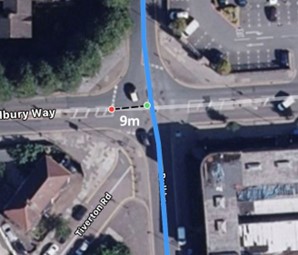 | On this route, the blue route line travels through a small roundabout, but does not follow the ground truth geometry of the roundabout. The distance between the outer edge of the roundabout and its approximate center is 9 meters. Doubling this width gives us an estimated roundabout width of 18 meters. As this is below the 50 meter threshold, this example should be rated as having a NonMNE – Other issue. |
 | On this route, the blue route line travels through a small roundabout, but makes a right turn as though this were a T-shaped intersection. The distance between the outer edge of the roundabout and its approximate center is 12 meters. Doubling this width gives us an estimated roundabout width of 24 meters. As this is below the 50 meter threshold, this example should be rated as having a NonMNE – Other issue. |
 | Here, a roundabout exists only on the blue line. In reality, we have an intersection that drivers can proceed directly through. From the outer edge of the roundabout to the approximate counterpoint of the roundabout is 17 meters. Doubling this width gives us an estimate roundabout width of 34 meters. As this is below the 50 meter threshold, this example should be rated as having a Non-MNE – Other issue. |
2.2.7. Other Issue Lat/Long Coordinates
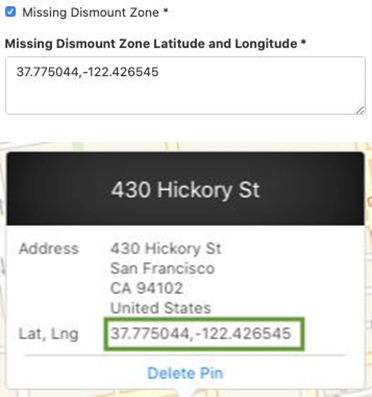
If you selected one of the Other Issues described in this chapter, with the exception of Excessive Maneuvers and Road Description, a Latitude and Logitude text field will appear and you will be required to provide the lat/long coordinates of the location where the issue occurs.
Enter only the numerical latitude and longitude coordinates in these text fields.
Do not add additional comments, explanations, formatting, punctuation, etc.
To prevent errors in transcribing lat/long coordinates, use the pin drop tool to obtain the coordinates, then copy them directly into the text field.

If more than one instance of the same MNE or Other Issue type occurs on the same route, enter lat/long coordinates for each instance.
Place each lat/long pair on separate lines, with no additional formatting or punctuation.
2.2.8. Multiple Options
You may select more than one Other Issue option. Once you have reviewed the cycling route, check the boxes for each Other Issue that appears on the route.
If more than one issue occurs at the same location (i.e. identical lat/long coordinates), choose the issue that would have the most severe impact on the cyclist.
3. How to Review a Route
3.1. Inch-by-Inch
The best way to spot errors in a route is to follow the route from start to finish, using the Satellite or Hybrid map layers.
As you inch through the route, you should keep an eye out for:
- Road/Path Availability – Does the route line correctly fall over cycling accessible roads/pathways? If it does not, how severe is the error? Minor misalignments between the Satellite and route line can be ignored but if the route line tracks over roads/paths that are not visible, further investigation should be performed to see if the road/path used in the route actually exists or if there is a Major Misalignment error.
- Road types and Cycling Safety – Are the roads/paths used in the route safe and legal for a cyclist to use? Do the large, busy roads have bike lanes or other areas safe for bikes to travel on? Visible bike lanes from satellite or street imagery can often indicate legality and safety.
- Look for Signs of Construction – In some cases, you may come across signs of construction. Construction could lead to temporary access restrictions and changes in bike pathways. When you see construction, you should make sure to check alternate sources to try and get an idea of the path’s shape. If alternate satellite or street imagery sources provide more a up-to-date view of the road, we can use that information to understand if road construction has resulted in an Access Restriction MNE.
- Other Oddities – Sometimes you’ll just see something that looks weird! Trust your instincts. If it looks odd, investigate further.
3.2. Deep Dive on Key Locations
One of the best ways to ensure route and map accuracy is to look for recent, street-level pictures of the road. The best sources of this imagery will be street imagery services. Using these services to see the road, as a user on the ground sees the road, can help you to understand the ground truth of the road, get an idea for road safety, find speed limits, etc. You are not limited to using only street imagery services as an additional source of information. Any photograph of the road, such as those on image hosting or business review websites, can be used as long as the imagery helps you understand the road as it exists today or in the recent past.
You should seek out street level imagery for any areas that look like they may not have a safe place to bike and roads that you suspect may not allow bikes to travel.
Similarly, in some cases, it can help to consult individual POI maps. For example, if the route navigates into a university or a mall and you have concerns that the satellite imagery and standard map are out of date, quickly looking to see if the university or mall offers a visitor map can be useful in helping to determine if the paths exist as shown.
This sort of research is not required for all portions of the map. However, you should examine any area that looks suspicious from your inch-by-inch review, as well as step changes, as satellite imagery alone is often not sufficient to find issues with turn and access restrictions.
4. FAQ
- There is conflicting information between street imagery, satellite, and other sources.
When you have conflicting information, base your decision on the most recent information available. For example, if street-level imagery shows a road segment with a bike lane but recent satellite imagery shows no bike lane, you can reasonably conclude that the bike lane has been removed at some point. As such, you will need to evaluate the road’s safety without the presence of a bike lane. If you are unable to determine the recency of satellite or street imagery, refer to other online sources and base your ratings on the most recent information available.
- It looks like there has been some recent construction along the route I am evaluating and the route segments may have been different at the time recorded in the Timestamp.
Rate against the most recent road geometry you can find. The time of day and the day of week are important when considering access restrictions. Some Bike paths may also be effected by seasonal restrictions.
- I’ve spotted multiple errors on the route that I am evaluating. Which one should I select?
You should record each error that you identify on the route. Begin by responding Yes, to either or both of the route error questions. Then select the checkbox for each error and provide lat/ long coordinates in the corresponding text fields.
- The blue Route Line starts or ends in a location that would make it difficult or impossible for a user to reach the Origin and/or Destination Pins. Does this qualify as a Major Navigational Error?
This does not qualify as a MNE. When rating Cycling Routing, we presume that the start and end points of the Route Line are acceptable to the user and the Route Line is rated independently from the origin/destination pins.
- Is it OK for a Cycling route to begin on a ferry?
Yes. If there is an existing ferry route that the user could use, then the route is allowed to begin on a ferry. Routes that begin on a ferry will usually not have an initial step indicating the route is beginning on a ferry (the advisory notice may still appear). When trying to determine if the route is beginning on a ferry, look at where it connects to land.
If the route is not connecting to land at a ferry terminal, it’s almost certainly not a ferry.
